A rash of fires this year has destroyed homes, subjected residents to evacuation orders and resulted in at least one death.
Here are some of the fires now burning in California:
- Loma fire: 2,250 acres burned in the Santa Cruz mountains; destroyed seven structures, including one home; 10% contained as of Sept. 28; began Sept. 26.
- Sawmill fire: 1,500 acres burned in Sonoma County; 55% contained as of Sept. 27; began Sept. 25.
- Canyon fire: 12,518 acres burned at Vandenberg Air Force Base in Santa Barbara County; fully contained; began Sept. 17
- Soberanes fire: 128,380 acres burned, one person killed and 68 structures destroyed in Monterey County; 81% contained as of Sept. 27; began July 22
- Share via
Loma fire destroys one home, triggers evacuations in Santa Cruz mountains
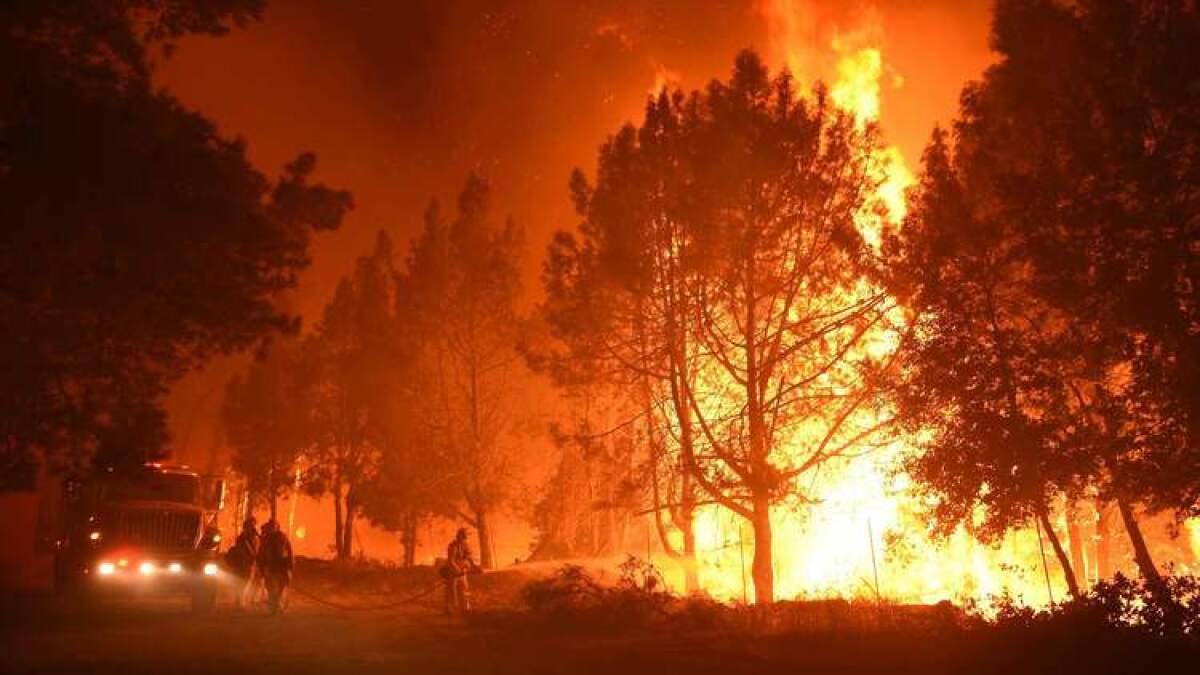
A fast-moving wildfire burning in the Santa Cruz Mountains has scorched at least 1,000 acres, destroyed a home and triggered evacuations.
Flames from the Loma fire are threatening at least 300 structures near Loma Prieta and Loma Chiquita roads, 10 miles northwest of Morgan Hill, in the mountains north of Santa Cruz, according to the California Department of Forestry and Fire Protection. Mandatory evacuations were issued to residents living in homes in the Loma area.
Triple-digit temperatures and dry conditions are driving the explosive blaze, which started about 3 p.m. Monday, according to Cal Fire Capt. Brian Oliver. The fire is 5% contained.
- Share via
Small brush fire erupts in Elysian Park near Dodger Stadium
Firefighters in Los Angeles on Thursday knocked down a 6.3-acre brush fire that started at 11:45 a.m. in Elysian Park near Dodger Stadium.
A water-dropping helicopter aided about 100 firefighters as they attacked the flames “hard and fast from the ground and the air,” the Los Angeles Fire Department said in a statement.
- Share via
High winds and low humidity will create dangerous fire conditions this week, forecasters say

Powerful winds, low humidity and landscapes left very dry from years of drought could create critical fire danger conditions in the Southland this week, starting Wednesday, forecasters said.
Gusty, northerly “sundowner” winds, with gusts up to 40 mph, are expected to begin Wednesday evening along the western edge of the Santa Ynez Mountains in Santa Barbara County, said Stuart Seto, a weather specialist with the National Weather Service in Oxnard.
- Share via
Firefighter killed, another injured in rollover crash while fighting Canyon fire
A Ventura County firefighter was killed and another was injured early Wednesday in a rollover crash near Lompoc as they were hauling water to the Canyon fire at Vandenberg Air Force Base.
The firefighters were assigned to a water tender by the California Governor’s Office of Emergency Services and headed to the 12,353-acre wildfire at about 6:20 a.m., when the rollover crash occurred on the westbound California 246, said Capt. Mike Lindbery, spokesman for the Ventura County Fire Department.
- Share via
Where is the Canyon Fire?
- Share via
‘Very active’ fire at Vandenberg Air Force Base grows to over 10,000 acres
A wildfire burning on the south side of Vandenberg Air Force Base near Lompoc has more than doubled in size since the weekend and now covers 10,542 acres, Air Force officials said Tuesday.
The Canyon fire was 18% contained, and 633 firefighters from federal, state and local fire agencies were battling the blaze.
The fire was “very active” Monday, growing by about 6,000 acres on the north and west sides, Air Force officials said in a statement.
Cultural sites related to the Chumash people and wildlife habitats are potentially threatened by the fire, and there are watershed concerns, military officials said. A team of resources advisers is working with fire crews to identify what is being threatened.
No structures have been damaged.
- Share via
Where is the Soberanes fire?
The cost of fighting the 189-square-mile Soberanes fire burning near Big Sur has passed $200 million, making it the costliest to fight in U.S. history, according to federal data.
- Share via
Canyon fire near Vandenberg Air Force Base swells to 4,500 acres
A wildfire burning on the south side of Vandenberg Air Force Base near Lompoc grew to 4,528 acres Monday despite an aggressive air and ground attack to stop flames from advancing.
Over the weekend, the Canyon fire forced officials to postpone the launch of an Atlas V rocket. The rocket was scheduled to take off Sunday and carry the WorldView-4, a commercial satellite that is to snap high-resolution images of Earth, according to United Launch Alliance, the contractor hired to lift the satellite into orbit.
The fire has caused power outages at several buildings on the base, according to Air Force officials. Generators are providing power to those facilities until downed power lines are repaired or replaced, they said.
The Air Force has further restricted public access to the site as crews worked to cut new fire lines and douse spot fires.
- Share via
1,200-acre wildfire at Vandenberg Air Force Base delays satellite launch
Nearly 800 firefighters from state, federal and local agencies have been dispatched to battle the Canyon fire burning at Vandenberg Air Force Base in Santa Barbara County.
The 1,200-acre blaze has forced officials to postpone the launch of a commercial satellite, authorities said.
“It’s burning in some very tough vegetation,” Wayne Seda, the assistant chief of the Vandenberg Fire Department, told reporters Sunday. “The fire grew rapidly.... It jumped roads at times and came out of the containment lines.”
- Share via
Where is the Holy fire burning?
The Holy fire in Orange County started in the early morning just east of Trabuco Canyon in the Cleveland National Forest.
The blaze wasn’t threatening any homes but was burning in steep, dry hillsides around Holy Jim Canyon that are difficult for firefighters to reach, said Orange County Fire Authority Capt. Larry Kurtz.
- Share via
Update on the Bogart fire in Riverside County: 1,250 acres have burned
Fire officials lifted evacuations for the Banning Bench area Tuesday night, allowing residents with valid identification to return home.
Authorities also said they believe the fire was caused by humans and have asked any witnesses who may have seen juveniles near the entrance to Bogart Park to call the arson hotline at (800) 633-2836.
- Share via
Firefighters on the scene of the Bogart fire
- Share via
700 displaced in fast-moving Bogart fire near Beaumont
About 700 people were displaced Tuesday as a fast-moving brush fire burned out of control near Beaumont.
The Bogart fire had burned at least 500 acres and was at 0% containment. About 200 homes were evacuated, according to Cal Fire.
It was burning north of Beaumont in Cherry Valley near the intersection of Winesap Avenue and International Park Road.
One outbuilding was lost, Cal Fire said.
- Share via
Fast-moving Bogart fire in Riverside County jumps to 400 acres; evacuations ordered
A fast-moving vegetation fire in Cherry Valley spread to 400 acres Tuesday afternoon, prompting evacuations for residents of a mobile home park and some homes northwest of Banning, authorities said.
The Bogart fire was reported at 12:25 p.m. near the intersection of Winesap Avenue and International Park Road, according to the Riverside County fire department.
Within an hour, the blaze jumped to 100 acres, then quadrupled by 3 p.m., fire officials said.
Residents were evacuated in the Highland Springs Village mobile home park and Banning Bench, a rural plateau northwest of Banning. An evacuation center was opened at the Albert A. Chatigny Senior Community Center in Beaumont.
More than 320 firefighters have been assigned to combat the blaze. They are being assisted by five helicopters, two bulldozers and nine air tankers.
Cherry Valley is located off I-10 in Riverside County, with a population of more than 6,300, census records show.
- Share via
New wildfire threatening homes in Kern County
A new fire broke out Friday in Kern County, prompting officials to ask some residents to evacuate.
The Range fire was burning in the Bear Valley Springs area. More than 600 acres have burned. According to the Kern County Fire Department, more than 400 firefighters were on scene and some were doing structure protection.
The fire is 0% contained. It was burning east of the town of Arvin off Highway 223.
- Share via
California wildfire updates: Stark drone video shows devastation from Lake County fire
The Clayton fire in Lake County destroyed scores of home and carved a path of destruction through Lower Lake’s downtown area.
New drone footage shows the aftermath of the fire.
KRON-TV said it used the drone after air restrictions were lifted by firefighters.
A Lake County man has been charged with intentionally setting the fire.
- Share via
Hearst Castle remains closed as Chimney blaze vexes firefighters
The Chimney fire in San Luis Obispo County was burning Tuesday about two miles east of Hearst Castle, where for days crew have been protecting the tourist attraction by cutting multiple fire lines.
The historic 165-room estate remains closed, and tours are canceled through Sunday, California State Parks said in a statement. Visitors with reservations through the weekend will be contacted about refunds, officials said.
The Chimney fire has challenged firefighters, who thought they had gained the upper hand before winds picked up and it exploded over the weekend, officials said. The blaze was mostly moving north, but fire crews were preparing for the winds to shift on Tuesday, said Cal Fire Capt. Lucas Spelman.
The fire is burning over a large area that has created dramatically different firefighting conditions, he said.
On the western side of the fire, closer to the ocean, high humidity on Monday held the moisture in the air and trapped the smoke, making visibility so bad that it grounded firefighting aircraft, Spelman said. On the eastern side, firefighters had had the “exact opposite thing going on,” with “exceptionally low” humidity, dry brush and fast-moving flames, Spelman said.
“It’s almost like the mountains are just doused in gasoline,” said Spelman, who has worked on numerous major wildfires already this year. “The brush is just burning at a rate that’s incredible.”
Right now, we’re at that point where I’m not surprised anymore. Before, maybe we’d have a fire that’d do this once or twice a year, and now everything in the beginning of the fire season is burning explosively. It’s not going to get any better this year. … It’s like we’re at war.”
— Cal Fire Capt. Lucas Spelman
- Share via
Destructive Blue Cut fire is fully contained
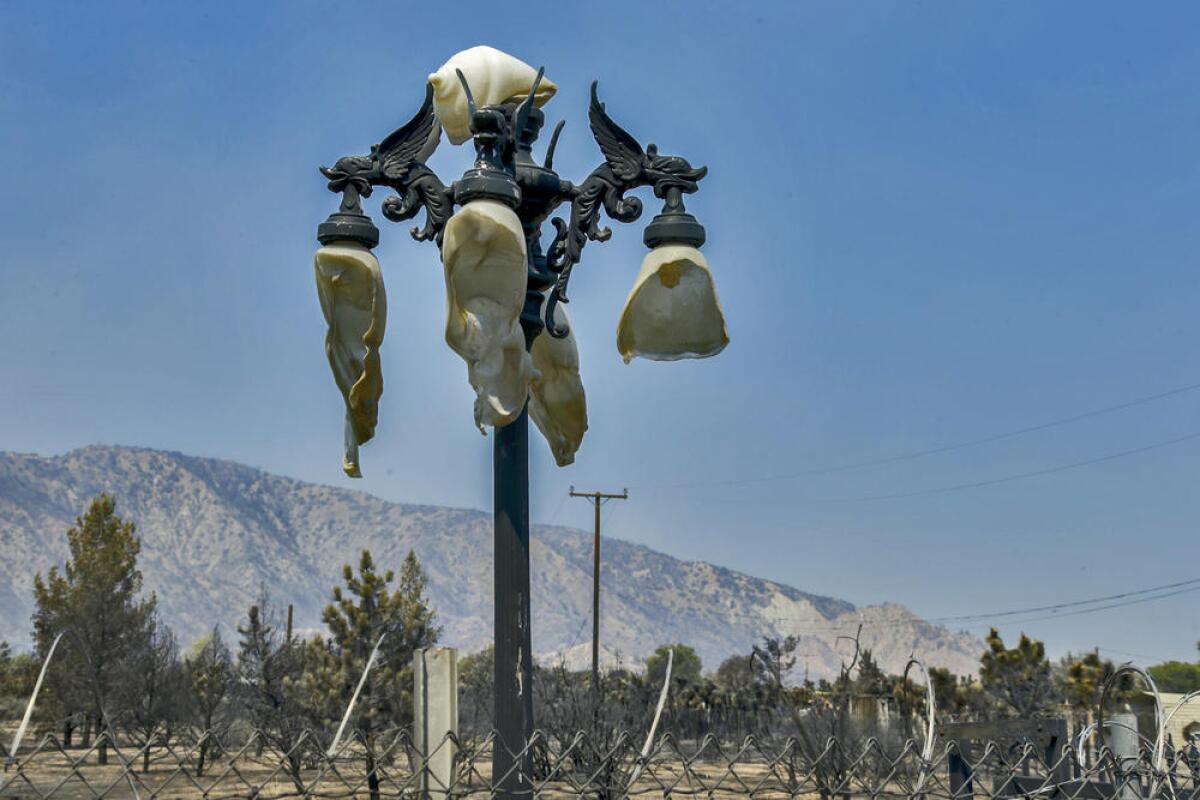
The Blue Cut fire, now fully contained after burning for one week near the Cajon Pass, destroyed an estimated 105 homes and 213 other structures in San Bernardino County and now ranks as the 20th most destructive wildfire in state history, said Daniel Berlant, a spokesman for the California Department of Forestry and Fire Protection.
The massive fire put more than 82,000 residents under mandatory evacuation orders and created major transportation problems when it forced the closure of the 15 Freeway and Highway 138 and scorched a stretch of freight railroad tracks that curve through the Cajon Pass.
The cause of the wildfire remains under investigation.
- Share via
Where is the Chimney fire burning?
- Share via
Where are California’s fires?
- Share via
Hearst Castle still closed, but Chimney fire’s progress is slowed
The Chimney fire expanded to 24,096 acres Saturday night as fire teams worked to prevent its advance toward historic Hearst Castle and other communities.
The fire’s leading edge was about two miles from the National Historic Landmark and museum Saturday, and firefighters have managed to arrest the fire’s advance by concentrating trucks and firefighters in the area between the castle and the fire. Winds and temperatures were also cooperating.
The castle remains closed to visitors.
- Share via
Images of the Chimney fire as it threatens Hearst Castle
The Chimney fire is now at 17,000 acres and threatening Hearst Castle.
Here are some images from the scene:
- Share via
Threatened by Chimney fire, Hearst Castle closes until further notice
The Chimney fire in San Luis Obispo County is threatening Hearst Castle and the buildings around it, Cal Fire authorities said Saturday afternoon.
The fire was headed toward the national historic landmark and the leading edge was just two miles away, said Cal Fire spokeswoman Emily Hjortstorp. Crews are expecting winds of up to 20 mph, but the fire isn’t traveling especially fast, she said.
Bulldozers, trucks and firefighters are digging containment lines around the castle, Hjorstorp said. No evacuation orders have been issued for the area.
- Share via
Destructive Blue Cut fire is 68% contained
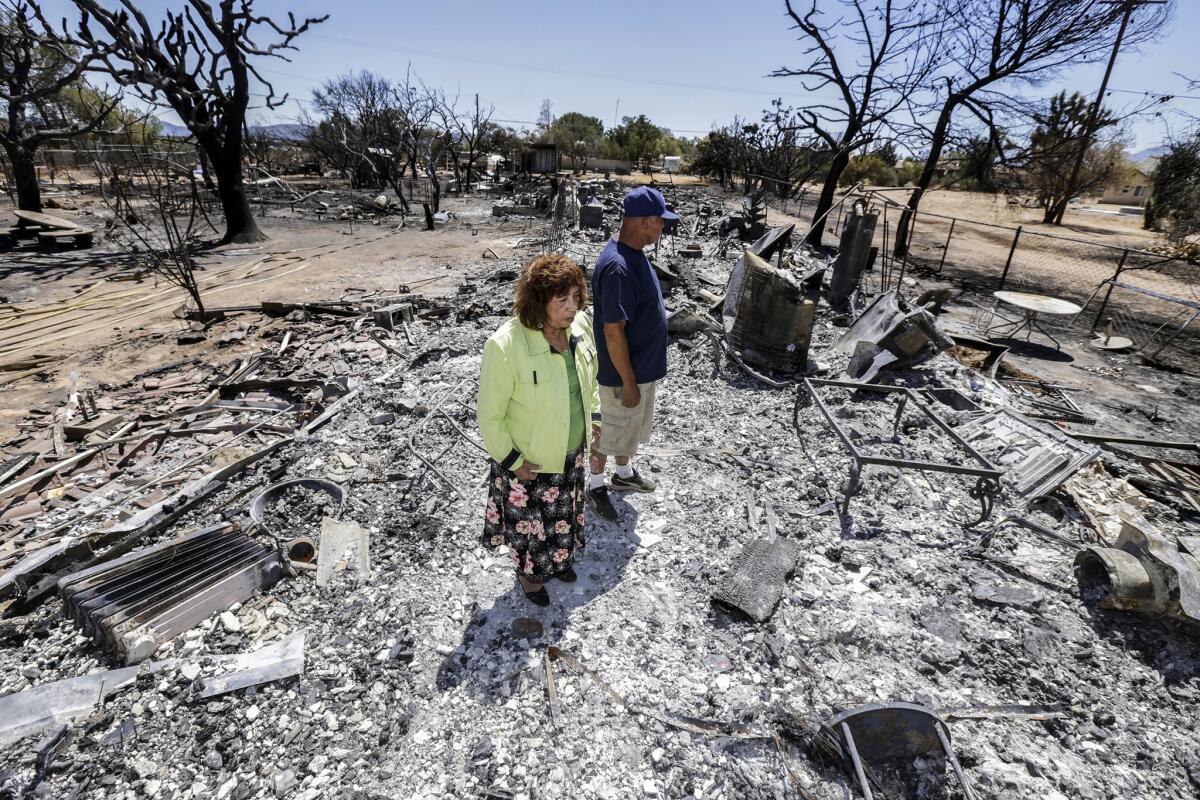
Firefighters tightened their grip on the fast-moving Blue Cut fire overnight Friday, capitalizing on humid weather conditions to gain greater control over the 37,020-acre blaze, authorities said Saturday.
The fire, which is 68% contained, has destroyed 105 homes and 213 other structures in San Bernardino County since it broke out Tuesday for reasons investigators are still trying to determine.
- Share via
Blue Cut fire in the Cajon Pass destroys 105 homes and 213 other buildings
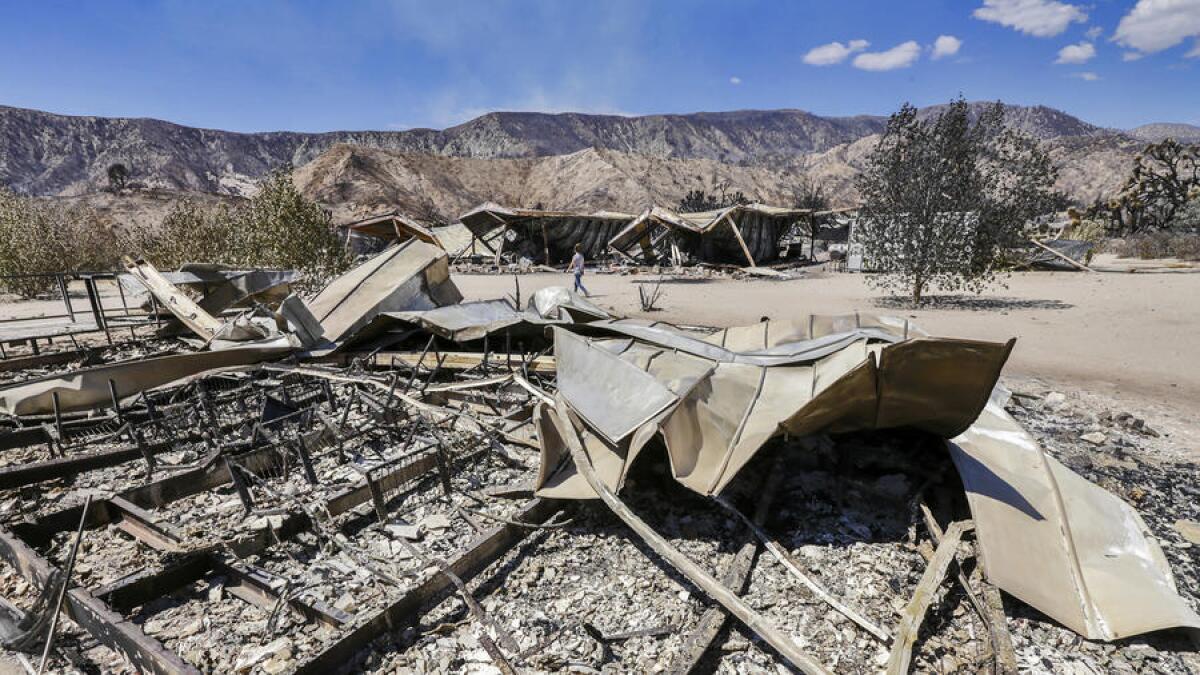
The tally for California’s harsh fire season ascended to even grimmer terrain Saturday as officials announced that the Blue Cut fire in the Cajon Pass has destroyed 105 homes and 213 other structures.
The toll in San Bernardino County caps a week of extensive losses across California, including 300 structures destroyed in Lake County in Northern California when a wildfire raced through the town of Lower Lake, hammering its downtown area.
- Share via
Satellite imagery shows the Blue Cut fire’s huge burn area
This “false color” image from NASA’s Landsat 8 satellite uses a combination of color and infrared bands to help distinguish burn scars and hotspots from vegetation.
The Blue Cut fire has scorched more than 37,000 acres so far. Satellite imagery captured Thursday shows the extent of the burn area. The Pilot fire to the east burned about 8,000 acres and was 100% contained by Tuesday.
- Share via
Korean church retreat burned to the ground in Blue Cut fire
Down a narrow dirt road off Highway 138 in Phelan, a popular Korean church retreat center sat in ruins.
About 10 buildings belonging to the Thanksgiving Korean Church were left in large piles of rubble Friday afternoon. Rows of scorched metal chairs remained standing in some buildings. Damaged sinks, stoves and washers in others suggest that they may have been used as living quarters.
Jinny Lee, owner of a cafe off Highway 138, walked past one singed building after another, trying to remember the one where the actual church services would take place.
“Maybe it’s this building,” Lee, 55, said, as she looked at the row of charred furniture.
- Share via
Woman loses 135 animals, beloved guesthouse in Blue Cut fire
The last time Mabel Ramos saw her peach-colored home was through the rear view mirror of her car as she was pulling out of her driveway soon after the Blue Cut fire started. She saw flames as high as an electricity pole surrounding her property.
“I was thinking, ‘Our Lord dear father, his son Jesus and the Holy Spirit, please, when I leave this gate, take care of my house,’” she said.
Ramos returned to her home late Thursday afternoon. When she got to the gate, she saw the charred Jaguar that she and her husband had driven off in after getting married. Then she saw the guesthouse that she and her husband had built together, now a pile of rubble.
“I cried,” she said. “It was terrible.”
On Friday she stood in what was once the living room of the guesthouse. The charred metal frame of a coffee table stood nearby. Other part of the house were still standing, including a cast iron wood stove.
She said the guesthouse was special. Her grandmother from El Salvador would stay at the guesthouse whenever she visit. Family from Canada also would use it. Her son, who lives in Los Angeles, used it as second home.
The shed that kept the animals also burned down. She lost 135 of her livestock.
“I didn’t have time to even open the door,” she said before crying.
- Share via
Blue Cut fire evacuations lifted for parts of Phelan
Effective Friday at 1 p.m., the mandatory evacuation orders for Phelan residents west of Baldy Mesa Road to Wilson Ranch Road south of Phelan Road to Mission Street affected by the Blue Cut fire will be lifted, according to the San Bernardino County Sheriff’s Department.
Baldy Mesa Road south of Phelan Road will reopen.
Eastbound Highway 138 from Interstate 15 to Summit Valley will also reopen.
- Share via
‘We have been arresting looters’: Deputies patrol Blue Cut fire evacuation zones
Assistant San Bernardino County Sheriff Shannon Dicus reassured Blue Cut fire evacuees Friday that his department’s primary focus was the protection of evacuated areas.
- Share via
New fire burning on Grapevine, homes threatened
A new fire was reported Friday in the Grapevine near the town of Lebec in Kern County.
There was no immediate size provided, but officials said some homes were threatened.
Interstate 5 remains open at this time.
- Share via
Rey fire grows to 1,000 acres and is still 20% contained
- Share via
Blue Cut fire has destroyed nearly 100 homes
The Blue Cut fire raging in the Cajon Pass has destroyed nearly 100 homes, officials said Friday as firefighters focused their efforts on areas near the mountain resort town of Wrightwood, where dry brush hasn’t burned in years.
According to preliminary estimates released by San Bernardino County Fire Chief Mark Hartwig, 96 homes and 213 outbuildings have been destroyed by the fire, which has consumed 37,000 acres.
Wrightwood on the west flank of the fire is dotted with apartments and small homes and has the highest housing density in the area.
The blaze is 26% contained, officials said, up from 22% Thursday evening.
- Share via
Truck driver in Cajon Pass ‘just kept driving’ and prayed the freeway would reopen
Kevin Holladay had a lot of time to think about whether he would risk the drive on the 15 Freeway.
He was on the road from Illinois to Anaheim to reload his tanker truck with chemicals. But there was a problem: The Blue Cut fire had closed the freeway.
Holladay, a thin man with blue eyes, long gray hair and a thick horseshoe mustache, said he listened to the news on the radio to keep tabs on the fire.
“I just kept driving,” he said, as he stood at the truck stop just off Highway 138 on Friday morning.
The Outpost Cafe sat nearby, a slogan hanging from its wooden roof: “The Place for meeting, eatin’ and getting gas.”
Holladay said he was praying the flames would calm down -- not because of the drive, but because of the destruction. He said his thoughts drifted to residents whose homes and animals were threatened by the wildfire.
He said that as he crossed into Nevada, he saw road signs that said the southbound 15 Freeway was still closed. At Las Vegas, another sign: still closed.
“I followed my instinct,” said Holladay, 53.
At the California-Nevada border, he saw another sign: The freeway was open. As he drove through the area, he saw some of the damage left behind.
“I was shocked,” he said. “Stuff you’ve seen for years is gone.”
- Share via
‘We were laughing. Then we realized, this is really serious. We need to get out,’ Santa Barbara camper says
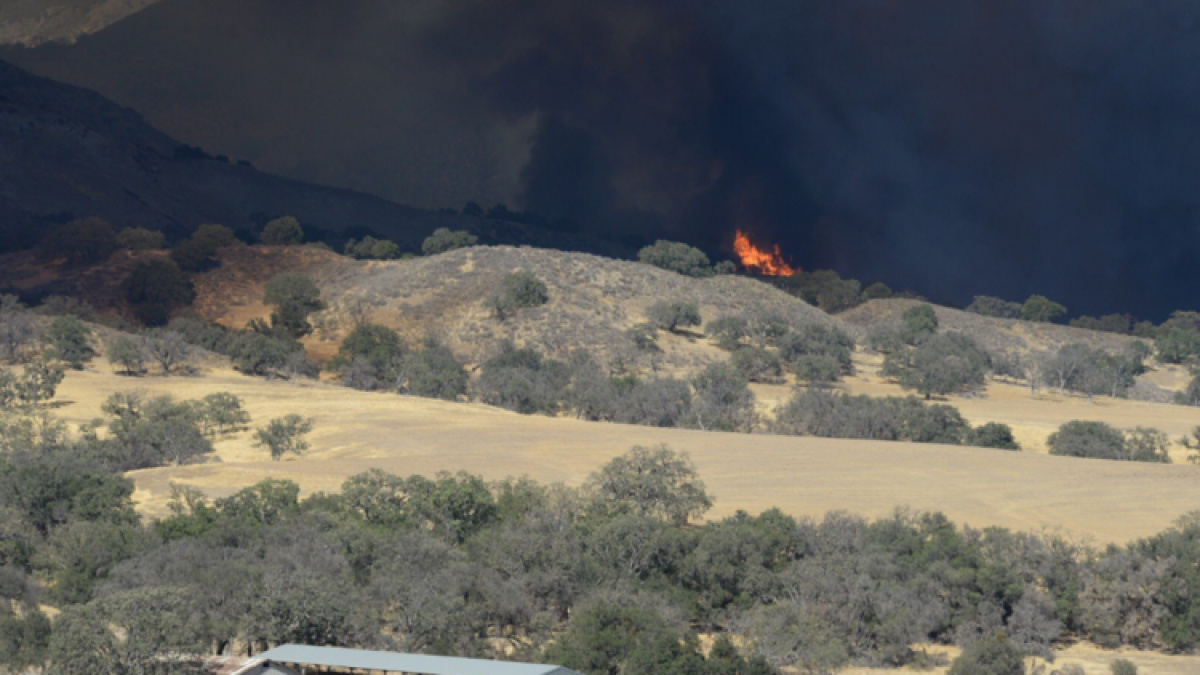
Kyle Joachim and his wife were driving back to their campsite in Santa Barbara County when they saw a strip of the hillside go up in smoke. Curious, the couple pulled over to take a look at what had happened.
As they watched the flames fan out, Joachim called 911.
“I couldn’t believe how quickly it spread,” he said.
Joachim, 36, and his family had been staying at the Fremont campsite. The edge of the Rey fire was only about a mile from the site, he said.
The seven of them had spent two days hiking around the area -- including parts of the forest that are now up in flames -- played games and checked out nearby restaurants.
They had planned on staying until Friday morning, but around 3:45 p.m. Thursday, a sheriff’s deputy came to the site and told the campsite host that everyone needed to evacuate.
A wildfire had erupted near the White Rock day use area nearby, the deputy told him. Joachim and his family quickly packed up their two tents and loaded their gear into their cars.
About a dozen people were staying at the campsite, Joachim said. Large signs at the entrance had advised campers that they could only make fires in designated areas, he said.
“The camp host came around the first day and was very specific that we could only have fire in the firepits,” Joachim said. “They had jugs of water next to the pits that said, ‘For fire only.’”
After speaking with the deputy, the camp host seemed panicked, Joachim recalled.
“At first we were laughing. Then we realized, this is really serious. We need to get out,” he said.
- Share via
Blue Cut fire grows to 37,002 acres and is 26% contained
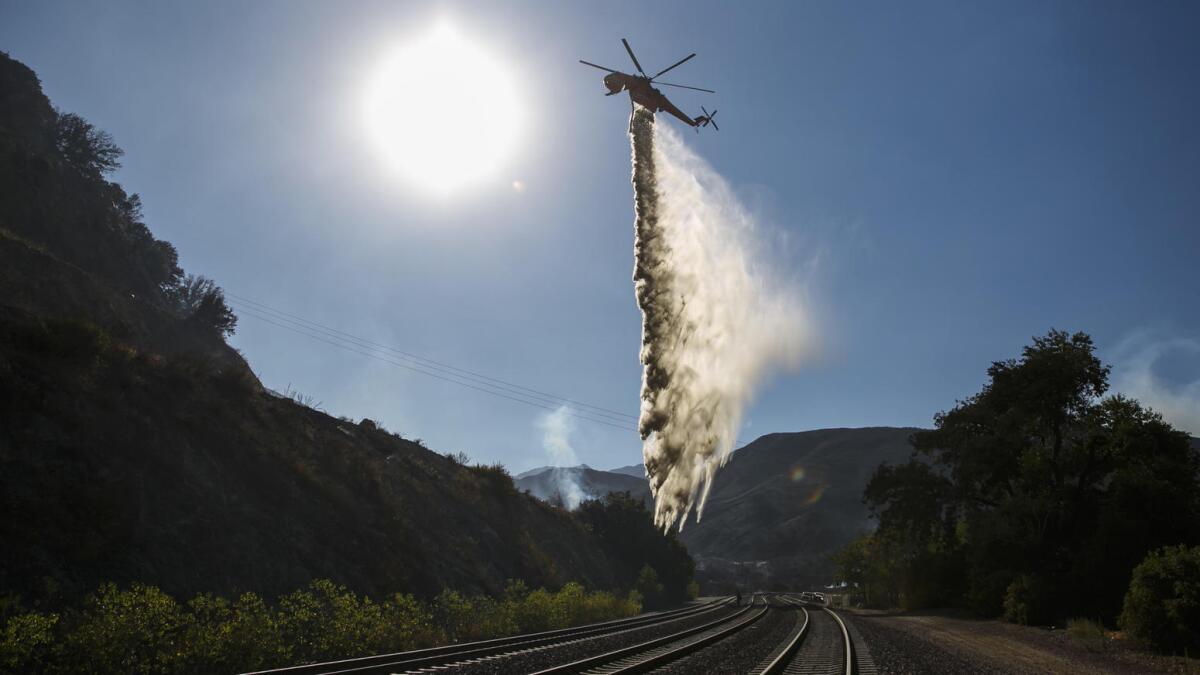
The raging Blue Cut fire in the Cajon Pass grew to 37,002 acres Friday morning, fire officials said.
Crews continued to focus on communities west of the fire, such as Lytle Creek and the mountain resort town of Wrightwood, which is dotted with apartments and small homes and has the highest housing density in the area.
The blaze is now 26% contained.
Firefighters centered their efforts on Lone Pine Canyon Road, the backdoor into Wrightwood, in hopes of preventing the flames from jumping over the ridge. Still, gusty winds, high temperatures and low humidity persist and could create the same challenges that have haunted crews since the fire broke out Tuesday.
Although the Blue Cut fire calmed slightly overnight and halted its march north and east, a red-flag warning remains in effect.
Some signs of progress were evident Thursday afternoon.
Mandatory evacuations were lifted in several communities, and Caltrans reopened the 15 Freeway, a key trucking and commuter route that runs from San Diego, through the Inland Empire and across the Mojave Desert into Nevada.
Its two-day closure had contributed to massive congestion, creating nightmares for both travelers and those trying to evacuate.
Highway 138, another major roadway in the area, was expected to remain closed until further notice, according to the California Highway Patrol.
- Share via
Fast-moving wildfire burning above Santa Barbara; evacuations ordered
A 500-acre brush fire north of Santa Barbara is burning out of control Thursday evening.
The Rey Fire was racing through dry forestland off Paradise Road amid winds and temperatures in the 90s, accoridng to Mike Eliason, a spokesman for the Santa Barbara County Fire Department.
Caltrans said a portion of Highway 154 was closed and urged motorist to use U.S. 101 as an alterative route.
Officials said some mountain cabins have been evacuated.
- Share via
Blue Cut fire continues to grow as some evacuation orders are lifted
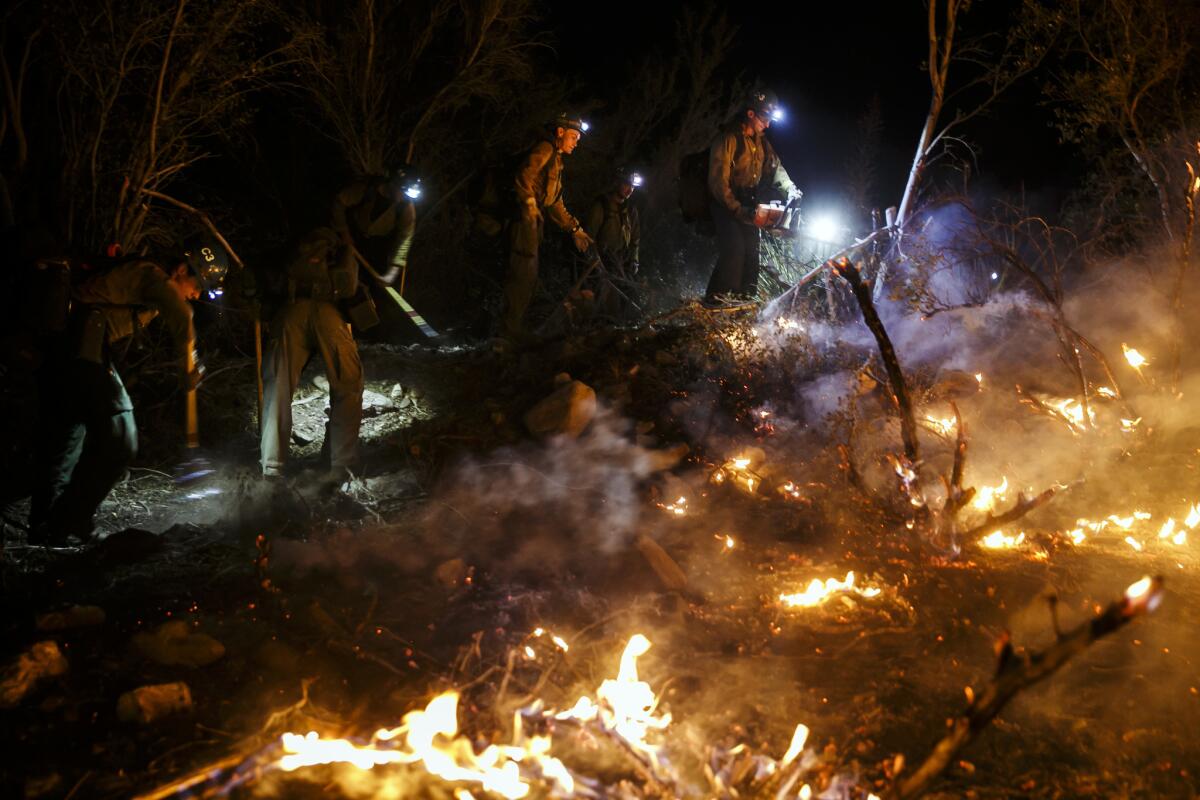
The Blue Cut fire grew to 35,969 acres by Thursday night -- an increase of more than 4,000 acres since the morning, authorities said.
Firefighters also increased their containment of the blaze to 22%, according to the U.S. Forest Service. The containment previously was 4%.
The unruly blaze is continuing its northerly march toward the high desert communities of Phelan, Wrightwood, Baldy Mesa and South Hesperia, according to the U.S. Forest Service.
Lytle Creek, a small mountainous community along the fire’s southwestern flank, was also under threat, officials said.
Some evacuation orders were lifted Thursday afternoon, including East Oak Hills and South Hesperia. Later in the day, authorities also allowed residents in West Oak Hills to return.
- Share via
Woman who lost everything to fire years ago refuses to be ‘blindsided’ again
Thirteen years ago, when the Grand Prix fire erupted in Lytle Creek, Sheri Sladwick had little time to pack. She stuffed her children, dogs and some clothes in the car before racing down the mountain to safety.
She returned to nothing.
Her two-story rental home, six family cars and treasured crystal collection disappeared in the flames.
On Tuesday, when San Bernardino sheriff deputies issued a mandatory evacuation as a fast-moving brush fire exploded in the Cajon Pass, Sladwick took time to pack the things she could not live without.
“This time I took a little longer because I didn’t expect to come home to anything again,” she said Thursday at a Red Cross evacuation center where residents forced to flee their home found refuge from the Blue Cut fire.
For an hour, she ran back and forth between her car and the sprawling lot where her three-bedroom home sat. She filled her Jeep Cherokee with three dogs, clothes, tools and her beloved crystal beads.
“I couldn’t stop to be choosy,” Sladwick, 46, said. “There were too many things that if I stopped and thought about it I just would’ve said, ‘Aw, I need this.’ There was just not enough room or time.”
Her belongings still block the back window of her truck, which is parked outside the Jessie Turner Community Center. There, in the parking lot, Sladwick strung up two blankets between two trucks to provide shade from the brutal sun.
She said she’s still reeling from the evacuation.
“That was the last thing I expected to do that day,” she said. “I had other things to do. I don’t even remember what was so important right before that that I worried about getting done. Now, I don’t even think about it.”
She has other concerns.
Her phone has been buried in the mess in her truck. She can’t bear to watch the news, worried that she might see her home. The last two nights she has slept in her truck because the shelter won’t allow pets.
Neighbors told her that her community center was destroyed, friends’ homes were lost and other structures burned. Later, she was told that the fire never made its way down into her enclave. She doesn’t know what to believe.
“Last time, I thought we were good,” she said. “I was blindsided. I don’t want to be blindsided again.”
- Share via
Suspected looters arrested in Blue Cut fire evacuation area
Three people were arrested on suspicion of looting in a Blue Cut fire evacuation area Thursday morning, according to the San Bernardino County Sheriff’s Department.
Daniel Mervine, 27, of Jurupa; Natasha Rovinsky, 27, of Diamond Bar; and Trevor Sanchez, 29, of Riverside, were arrested on suspicion looting and grand theft auto, according to the department.
The trio were spotted driving a large flat-bed truck from a residence in the 8600 block of Swarthout Canyon, in unincorporated San Bernardino County, at 7 a.m.
“The suspects told deputies they were picking up property for a friend that lived at the residence. Deputies made contact with the property owner who advised that he did not give anyone permission to take his property,” a department statement said.
Anyone with further information on suspected looting is asked to contact the Sheriff’s Central Station at (909) 387-3545.
- Share via
Authorities lift some evacuation orders connected to Blue Cut fire
Santa Fe/Summit Valley Road and Arrowhead Lake Road/Highway 173 are now open, the San Bernardino County Sheriff’s Office said in a statement.
Highway 138 remains closed at the 15 Freeway, east to Summit Valley Road, officials said.
- Share via
‘We’ve been through a few of these,’ says resident who stayed to protect home from Blue Cut fire
Michael Barnes has lived in his home along Highway 138 for about 23 years. When the Blue Cut fire erupted Tuesday, he and his family stayed.
“We’ve been through a few of these and we stay here,” he said. “We keep it pretty much pushed back to give us a chance. The fire department, they rolled in and they rolled out before the fire hit. We were here to stop the fire. I don’t know where they went.”
He and his family have dealt with four fires, including this one, he said.
The fire came from the southeast. His family saw it coming and began using a tractor to clear brush as trees near their home caught fire.
Family members ran around with buckets and hoses and used a water truck to put out hot spots.
“I’m glad it’s still here,” Barnes said of his home.
A construction company let the family use its equipment, which included the tractor and water truck, he said.
“It saved a few homes,” Barnes said. “We were using that to try and help others out.”
The water truck helped save the home of a neighbor Barnes had sent his son to check on.
“He got up there and came running back down and said he was in bad shape,” he said. “So we went up there and helped him out. Pretty much everything around his house burnt. He lost his tools, his barn, his equipment. But his house is standing.”
Others along Highway 138 were less fortunate, including a few neighbors who lived behind Barnes.
- Share via
As fire threatens his home, a Phelan man flees to his van
John Paik, 77, has lived on a steep hill off Highway 138 for a decade, but on Tuesday, he fled to a friend’s house as the Blue Cut fire crept toward his home in Phelan.
The fire burned a small lot filled with cars about 100 feet from his home, but so far, Paik’s house has been spared.
Paik said he has lived intermittently in his van over the last two days. When he left his house Tuesday night, he said, he didn’t bring anything with him, but returned to his powerless home the next day to get clothes and his passport.
“The firemen worked hard,” he said. “I had … confidence, maybe overconfidence, so I just brought nothing.”
As Paik drove in his van (which was stocked with cat food in the front seat), he stopped twice to chat with his neighbors. One asked Paik for an update on the fire.
Paik said he plans on staying in the area, for fear that if he leaves, it may be hard to get back up the dirt road to his home.
Asked why he moved to the desert, Paik said it reminds him of home in South Korea, filled with dirt roads and rolling hills and occasionally dusted with snow.
- Share via
No clear path to extinguishing Blue Cut fire, expert says
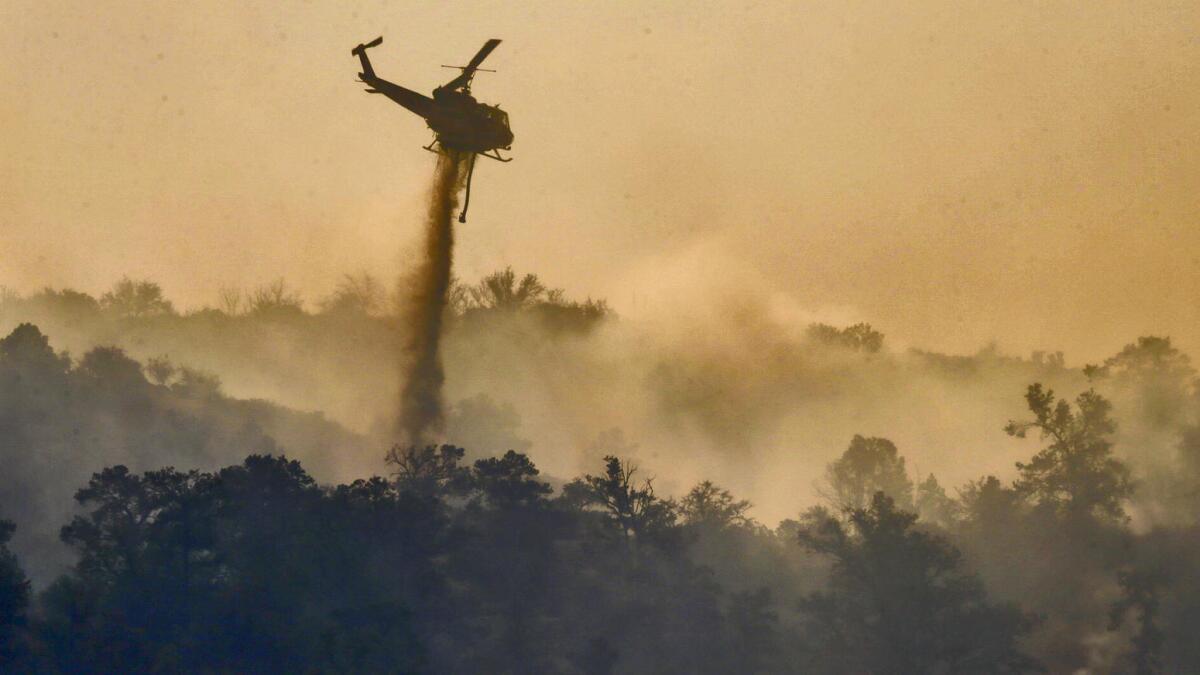
Fire crews’ safety is always high on the list of priorities for first responders battling explosive flames, said Sam Lanier, a retired fire captain.
Firefighters use standard guidelines to maneuver amid a fire, he said, prioritizing life safety over property conservation and property conservation over environmental protection. But there is no one-size-fits-all approach.
“It helps the firefighters,” he said, “but every fire is different. There’s not a set ‘If this is happening, do this.’ It’s all up to the best judgment of the firefighters.”
Aircraft are the biggest help in fighting a massive blaze like the Blue Cut fire, said Lanier. As the air attack crews explore the land from above, they broadcast the problem areas to field troops over the radio.
“There is no premade map to say we’re going to protect this area first,” Lanier said. “It’s what they see on the ground and what they see in the air that determines whatever they can do to help to mitigate the firefight.”
There is a common misconception that firefighters will protect the most expensive properties or biggest towns first, Lanier said, but that’s never the case.
“Firefighters are blind to the cost,” he said. “The job is to go and save as much as possible.”
The difficulties firefighters throughout the state face are compounded by drought conditions, he said. The drought leads to “beetle kill,” he said, referring to when beetles harvest and live on dry pine.
The insects essentially infect the trees, leaving them bone-dry, ready to ignite.
Fire crews in the Cajon Pass have likely had difficulty assessing the damage and number of homes lost because of safety concerns and protocol that grants wildland firefighters the right of way over those who assess.
“It can affect the wildland firefighting if there’s multiple vehicles out there,” Lanier said. “The engines have to get to the homes and get into the other areas. If multiple vehicles are there, it’s hard to get out.”
Utility companies are not allowed on roads either, he added, because first responders want to keep the vehicle count on the roads low.
Crews are likely now focused on perimeter control, Lanier said.
“That’s always a very tough one when you’ve got very active winds and fuels that are extremely dry,” he said. “It’s been a long fire season.”
- Share via
Beverly Hills firefighters aid dogs that survived Blue Cut fire
While on patrol in Phelan looking to mop up spots fire, Beverly Hills firefighters paused to assist two dogs that appeared to suffer from smoke inhalation.
The firefighters left two silver buckets for the dogs -- one with food and another with water.
The dogs were eventually recovered by San Bernardino County animal control officers.
- Share via
Blue Cut fire wreaks havoc along Highway 138
The earth around Highway 138 is scorched. The power poles that stand are blackened. Others, their wood splintered, lean.
A pinwheel spins in a backyard, near the smoldering carcass of a home. Nearby, in a garden, a sign creaks, swaying gently in the breeze. It reads:
“The kiss of the sun for pardon
The song of the birds for mirth
Ones is nearer God’s <3 in a garden
Than any place on earth”
The wood that holds up the entrance to the garden is charred and one of the doors is burned black.
Inside the garden, crosses are planted bearing names and dates. One of them reads “RIP,” with one of the wooden pieces hanging after being scorched by the fire.
Farther down the road, the wheels of a burned car are almost gone.
The breeze stirs up the ash, sending it swirling along the ruins.
- Share via
On Lone Pine Canyon Road, pieces of a charred house remain
There are only three homes here on Lone Pine Canyon Road — two at least partially saved, one destroyed.
The destroyed house, small and built of rocks and cement, was charred by the Blue Cut fire that swept through this area in recent days. On Thursday, it sat blackened at the end of Lone Pine Canyon — a long, narrow dirt road that winds past oil drums.
A thin plastic pipe attached to the house leaked water, and panels from the home’s tin roof dangled among charred cans — some forced open by the heat of the fire. The metal frame of a bed and a toilet seat remained, shattered.
A second building on the same property also laid in rubble, though weeds sprouting through cracks of the building’s foundation suggested it long had been unoccupied.
Only a chimney survived the destruction.
- Share via
Fire spokesman: Homes lost in Swarthout Canyon and West Cajon Valley; Wrightwood and Lytle Creek are under threat
The Blue Cut fire calmed slightly overnight and halted its march north and east, fire officials said Thursday morning.
But communities to the west of the fire — such as Wrightwood and Lytle Creek — remain threatened, said Eric Sherwin, an incident-response spokesman with the San Bernardino County Fire Department.
“Of all the communities under mandatory evacuation, the highest housing density exists within the community of Wrightwood,” Sherwin said.
The mountain-resort town is filled with apartments and small homes — not the sprawling ranch-style properties that dot the landscape in surrounding neighborhoods, Sherwin said.
If the fire behaves Thursday similar to how it did Wednesday, crews fighting the flames will face challenges.
The heat from the fire, fueled by dry brush, has created intense flames that have pushed through the retardants laid down by air crews, Sherwin said.
“Multiple times yesterday the fire jumped the retardant line,” Sherwin said. “We have the potential for that type of activity to return.”
Because the fire is still exhibiting erratic behavior, damage assessors have not been able to survey the destruction caused by the blaze, officials said. But they say that they know homes have been lost in Swarthout Canyon and West Cajon Valley.
Firefighters are focusing on Lone Pine Canyon Road — a backdoor to Wrightwood — to prevent the blaze from jumping over the ridge and into the mountain community. But nature is not on the firefighters’ side, as gusty winds, high temperatures and low humidity persist.
Explosive fire behavior, typically seen between 2 and 4 p.m., is occurring as early as 10 a.m., officials said.
“This fire,” Sherwin said, “is large and complex.”
- Share via
After long delay, 15 Freeway open in both directions again through Cajon Pass
- Share via
Putting out hot spots along Highway 2
- Share via
CHP says southbound 15 Freeway is reopening
- Share via
Scared and alone in Lytle Creek, resident waits for the lights to come on
A greeting painted along Lytle Creek Road welcomed residents to the area Thursday morning, though the town seemed mostly deserted. The sun’s rays highlighted the fire retardant-covered ridges and caution tape fluttered in a slight breeze outside empty homes.
Maria Hadaway, 62, likened it to a “SpongeBob SquarePants” episode in which the cartoon character wakes up alone in his town.
“That’s me -- I’m SpongeBob in Bikini Bottom,” she said. “It’s pretty scary. ... I’m hoping they let everyone up here, because I don’t like being alone.”
Hadaway, who has lived in her home off Lytle Creek Road for about 13 years, stayed because of her dogs. Sitting outside her home with a neighbor Thursday, she said authorities had come to her door, but Hadaway locked up, closed the drapes and didn’t answer.
Until Wednesday, Hadaway hadn’t worried much, but when the lights went out and the smell of smoke filled the air, she said she “got scared.”
Although the community still has water, Hadaway said her supply runs on an electric pump. So she’s been going to a creek near her home to fill buckets full of water to flush the toilet.
“I just wish the electricity would come back on,” Cestari said.
Meanwhile, fire trucks zipped up and down Lytle Creek Road on Thursday, a welcome sight for Hadaway, “because then I know everything’s OK.”
- Share via
Twitter user captures Blue Cut fire in stunning time-lapse video
- Share via
Blue Cut fire leaves behind a tangled mess
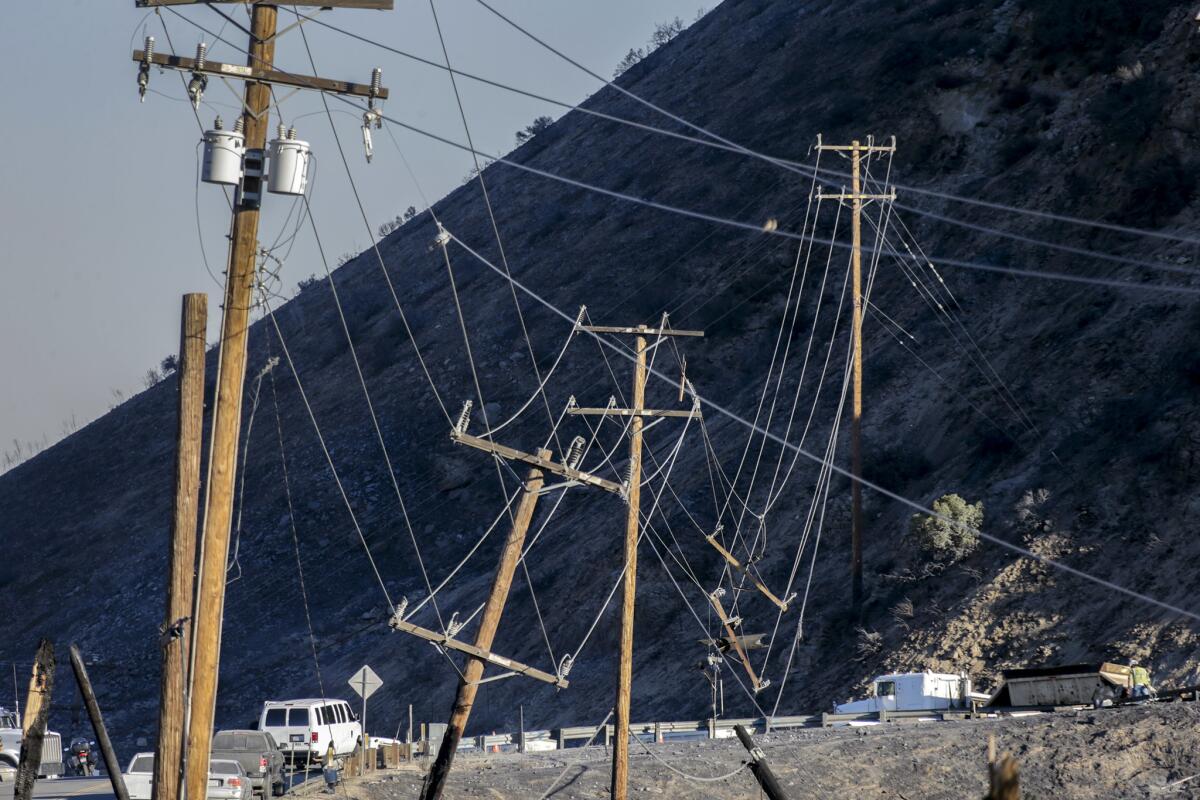
Work crews prepare to repair downed power lines damaged by the Blue Cut fire on Highway 138 at the junction with the 15 Freeway.
- Share via
The wait continues on the southbound 15 Freeway as Blue Cut fire rages
As the Blue Cut fire continues to grow, authorities are stopping traffic at multiple locations.
Traffic heading west on Main Street is being stopped at Highway 395. Drivers are being asked to get on the 395 and head north.
Meanwhile, cars heading west into Phelan on Bear Valley Road are being stopped before reaching Baldy Mesa Road -- a key Phelan artery that runs north and south.
Truckers are feeling the pain of the continued closure of the southbound 15 Freeway. About 25 big rigs are parked in dirt lots and along curbs near Main Street in Hesperia.
- Share via
Full moon shines light on destruction from Blue Cut fire
- Share via
Blue Cut fire leaves smoldering ruins behind
Times reporter Ruben Vives is back out on the scene of the Blue Cut fire this morning.
- Share via
More than 1,500 firefighters are battling the Blue Cut blaze
More than 1,500 firefighters continue to battle the Blue Cut fire on Thursday as flames ripped through canyons and flatlands and reduced homes to ash and rubble.
Although crews made some progress against the blaze, which was 4% contained as of 6:30 a.m., a red flag warning is still in effect, meaning weather conditions are prime for a fast-moving, destructive wildfire.
- Share via
As night falls, firefighters toil to protect homes in the fire’s path
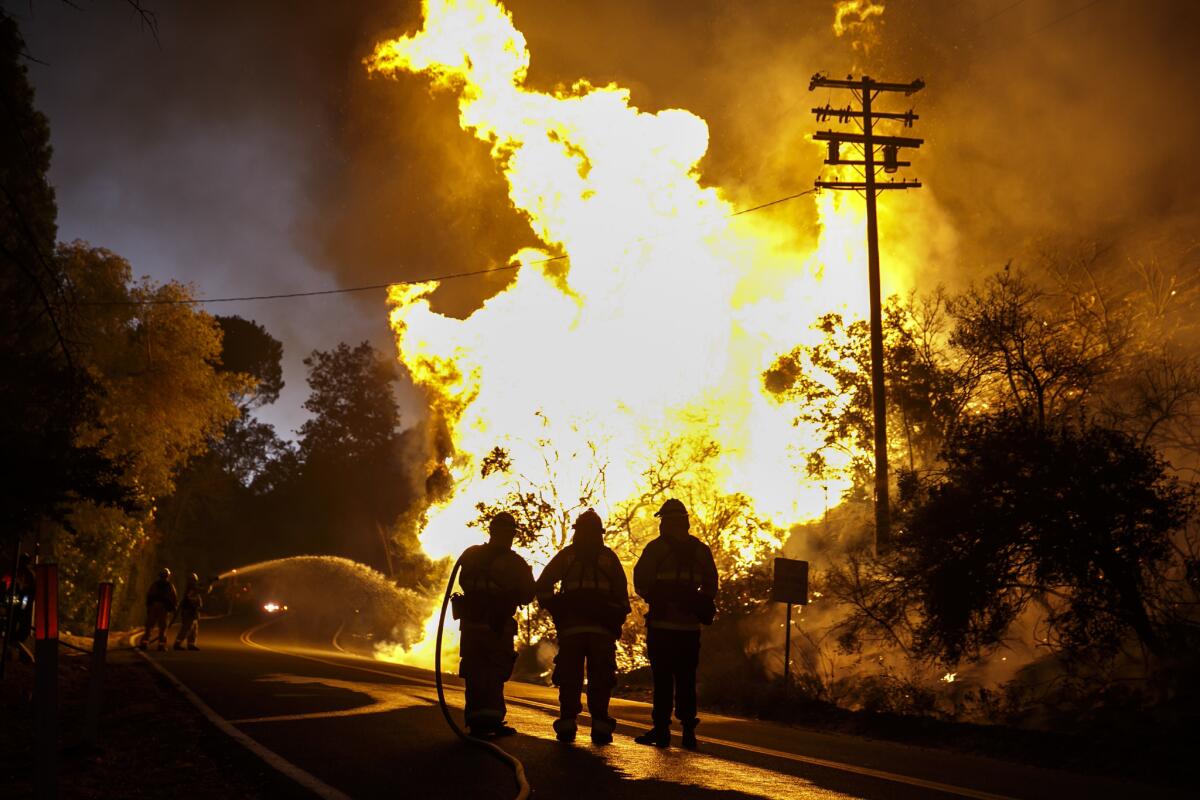
As night fell Wednesday, the Blue Cut fire marched toward Highway 2, also known as the Angeles Crest Highway.
Dozens of homes along this stretch of the highway -- communities including Wildhorse Canyon and Wrightwood -- stood in the path of the blaze.
Meanwhile, firefighters in Lytle Creek, near the fire’s southwestern flank, toiled to control the flames and prevent the fire from decimating the small, rural community.
Special helicopters equipped to fly in darkness were deployed, according to Melody Lardner, a spokeswoman for the U.S. Forest Service. More than 1,500 firefighters have been dispatched, with more crews and helicopters en route, the forest service said.
Officials are expected to provide updates Thursday morning about the status of the Blue Cut fire, which was only 4% contained.
In the meantime, check out coverage by reporters and editors at the Los Angeles Times:
- Share via
Northbound 15 Freeway reopens through Cajon Pass after devastating wildfire, CHP says
The northbound lanes of the 15 Freeway through the Cajon Pass reopened late Wednesday, according to the California Highway Patrol.
The freeway, a key trucking and commuter route that connects Southern California with Nevada, was closed after the 25,626-acre Blue Cut fire erupted Monday in San Bernardino County.
The CHP reopened the connector road between the northbound 15 Freeway and the 215 Freeway about 10:15 p.m. Shortly thereafter, the northbound 15 Freeway lanes were reopened.
Several off-ramps from the freeway remain closed, including Kenwood Avenue, Cleghorn Road, Highway 138 and Oak Hill Road, according to the state Department of Transportation.
The southbound lanes of the 15 Freeway, as well as Highway 138, another major roadway in the area, were expected to remain closed until further notice, according to the CHP.
Caltrans crews were working to repair guardrails and sections of the road damaged by the massive fire.
The freeway runs from San Diego, through the Inland Empire and across the Mojave Desert into Nevada. The reopening of the roadway will probably ease congestion prompted by the massive evacuation of residents around the Blue Cut fire’s burn area.
Caltrans advised motorists to drive with a full tank of gas and to be prepared for delays.
- Share via
Night view of the Blue Cut fire
- Share via
Columns of smoke from the Blue Cut fire are visible from space
A NASA satellite passed over Southern California just before noon on Wednesday, and it captured a bird’s-eye view of the 25,600-acre wildfire in the mountains of San Bernardino County.
From high above, the Blue Cut fire appears as three plumes of smoke from the mountains east of Los Angeles. The urban sprawl of L.A. and its surrounding cities look like a stretch of gray abutting the deep blue ocean.
NASA said the cloud of smoke spreads northeastward over the eastern boundary of California and extends into Nevada.
The imaging tool used to capture the snapshot of the smoky blaze was built and is managed by NASA’s Jet Propulsion Laboratory in La Cañada Flintridge. The satellite on which the imaging instrument is affixed is managed by a NASA office in Maryland.
- Share via
Couple hunker down in Phelan, pledge to fight for their home
For about 30 years, John and Diane Hayball have lived in their home on Johnson Road in Phelan. They raised their three sons there and built lives for themselves.
Living in a rural outpost, 68-year-old John said, means being prepared for anything – including the Blue Cut fire that has driven many of his neighbors from their homes. The Hayballs stayed behind, though, choosing to try and fight if the flames drew near.
On Tuesday, Diane, 65, was babysitting her granddaughter when she happened to walk outside and saw a plume of smoke.
“By the time I came in and told [John] and we both came outside again, it was just massive,” she said of the fire. “That’s how fast it grew.”
Diane soon got a call ordering mandatory evacuations in the area, which she said seemed premature.
Still, the couple laid out hoses and shovels to prepare. And if things get hairy in the coming hours and days, John said his family has three vehicles they can use to get themselves, their two dogs and two cats out.
“We will fight,” John said. “We don’t give in.”
In fact, the couple said they were ready to take on looters.
“We have guns,” John said. “If you loot, we shoot. It’s that simple.”
The Hayballs already have some experience staying put.
Twenty years ago, another fire prompted sheriff’s deputies in a helicopter to order evacuations.
The couple didn’t leave then either, John said.
“Bottom line,” Diane said, “it’s home.”
- Share via
Evacuees face freeway closures and jammed back roads
The Cajon Pass is one of Southern California’s most vital transportation links, connecting Los Angeles to Las Vegas and serving as a key shipping route for trucks headed east with produce and goods.
The massive wildfire that ripped through the pass this week closed several major freeways and roads, causing a commuter nightmare that also complicated the massive evacuation effort. Motorists and truckers were left stranded on either side of the closure.
Officials closed dozens of miles of two major commuter and trucking arteries after flames from the Blue Cut fire roared down a mountainside Tuesday night and jumped the 15 Freeway, damaging guardrails and scorching abandoned big-rig trucks.
Commuters and evacuees sought alternate routes to the 15 and Highway 138 on Wednesday, taking smaller, mountainous roads toward the high desert and to Los Angeles. Traffic snarled most roads in the area, with jams rippling outward to Yucca Valley in the east and to San Bernardino in the west.
- Share via
Blue Cut fire now 4% contained; burn area revised to 25,626 acres
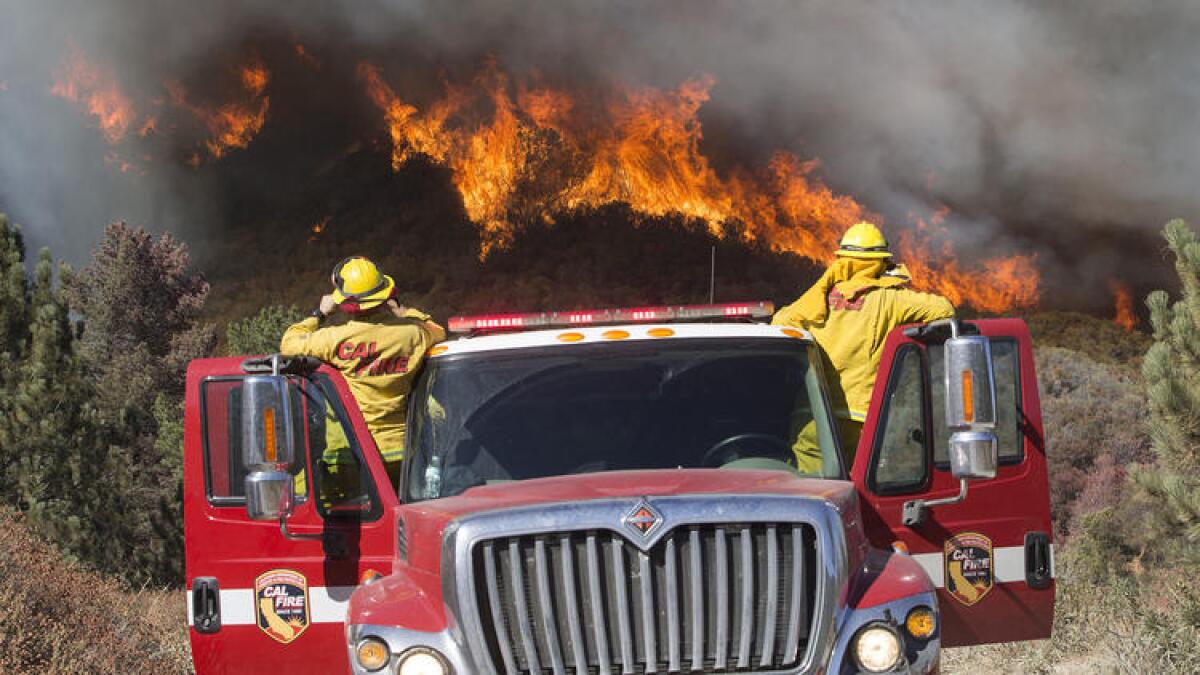
By late Wednesday, the Blue Cut fire had burned 25,626 acres and was 4% contained, according to Melody Lardner, a spokeswoman for the U.S. Forest Service.
The official measurement of the raging wildfire in the Cajon Pass was about 4,400 acres less than reported earlier in the day – a discrepancy that officials attributed to more precise mapping of the burn area. Previously, fire officials said the blaze was not contained.
The Blue Cut fire has forced more than 82,000 residents to evacuate, and officials said all evacuation orders and road closures – including the closure of the 15 Freeway – remained in place.
More than 1,500 firefighters were working Wednesday to control the blaze.
- Share via
2015 Rocky fire was sparked by illegal marijuana operation, officials say
A fire that destroyed 43 homes last year in a largely rural area north of San Francisco was sparked by an illegal marijuana growing operation, officials said Wednesday, and the two suspects fled the country before they could be questioned.
The Rocky fire burned about 108 square miles in Lake, Yolo and Colusa counties, destroying 43 homes and 53 outbuildings before it was contained.
It began near where firefighters are currently battling the unrelated Clayton fire that investigators say was caused by a serial arsonist.
Last year’s fire was started by a faulty water heater near where about 100 marijuana plants were being grown east of Clearlake, said California Department of Forestry and Fire Protection spokeswoman Janet Upton.
“It was strapped to a tree. Quite inventive and why it was not very safe,” she said.
- Share via
Longtime Wrightwood resident: ‘I’ve never seen anything like’ Blue Cut fire
Ken Bisson, 68, has lived in a Wrightwood for 32 years and has seen his share of fires.
But the Blue Cut fire is different, he said. He’s amazed by how quickly the hot and dry conditions enabled the fire to burn so many acres in such a short time.
“I’ve never seen anything like that,” he said, watching the fire burn on the side of a mountain near Pacific Crest Estates.
With his hands crossed behind his back, he listened as the fire roared and crept farther north along the side of the mountain.
“As long as the wind doesn’t change we’ll be OK,” he said.
Sitting on his porch not far away, Joe Knowlton, 49, watched as the fire raged.
“I stayed just in case there’s a chance that I can do something to save my house,” Knowlton said. “I know people say you shouldn’t stay because you get in the way, but I just think there’s things you can do as homeowner.”
Knowlton said he watered his home down and was now standing guard, watching the fire. If an ember falls on his property, he said, at least he’ll be around to stop it.
“That’s the difference between the house going up in flames or not,” he said. “That’s why I don’t mind sticking it out.”
- Share via
Couple keep in contact as husband insists on protecting home
At a supermarket in Phelan on Wednesday, residents grabbed groceries and bottled water as an employee pushed carts outside with a mask over her face.
Jana Maccabe packed up her car, preparing to head back to a friend’s house. She had evacuated from her home in Wrightwood, where she has lived for about 30 years.
Maccabe’s husband, a retired L.A. County firefighter, stayed behind to protect their home.
“It’s what he does,” she said, wiping a tear away. “Do I like it? No. But he’s doing what he does best.”
Maccabe said Wednesday was not the first time she has had to evacuate over the years.
“But this is the worst one that I’ve seen,” she said. “It moved so fast.”
She and her husband have been speaking every hour. As Maccabe loaded the car, her husband called and she filled him in on where she was and what she was doing.
Before the two hung up, she told him she loved him.
- Share via
Raw video of Blue Cut fire in Lytle Creek, Calif.

Raw video of aerial assault on the Blue Cut fire in Lytle Creek
- Share via
Prosecutors: Man accused of setting Clayton fire has started several others in Lake County
Clearlake, Calif., resident Damin Pashilk has started or tried to start 17 fires in Lake County since July 2015, prosecutors said.
In a probable cause declaration submitted by an investigator that was released publicly after Pashilk’s arraignment Wednesday, Pashilk appeared to plant most of his fire ignitions near rural highways north and east of the freshwater lake Clear Lake.
According to the document, Pashilk started two fires within 20 minutes of each other on July 2, 2015, along State Route 20, a scenic highway that connects the town to Interstate 5.
The following month, he allegedly tried to start fires in the middle of Clearlake, including one next to Pomo Elementary School.
Surveillance footage put Pashilk’s car near each of the fires when they were started, the document stated. The Pomo Elementary fire was connected to Pashilk by GPS tracker, according to the document.
Pashilk’s activity appeared to subside after the summer, but picked up again last month, the document alleges.
Fires began to spark up again in Clearlake, then farther south in Lower Lake, along Highway 29.
At least a half-dozen fires started along the highway, not far from where the 4,000-acre Clayton fire ultimately ignited.
On July 27, Pashilk allegedly attempted to start a fire near the Holiday Island mobile home park in Clearlake. A week-and-a-half later, GPS trackers put his vehicle near where a matchbook had started a small blaze in Lower Lake, though it burned itself out. Four days later, the Clayton fire began.
According to the document, “Pashilk was interviewed and could not provide an explanation to being at the ignition sites of the fires.”
He was arrested Monday.
- Share via
‘I’m just a nervous wreck’: Impacted residents stuggle to return home
Traffic slowed to a crawl along Pearblossom Highway on Wednesday, as motorists tried to make their way to Phelan.
As soon as drivers neared signs to continue onto other roads, they were redirected by a CHP officer who said the roads needed to be cleared for emergency vehicles and evacuees.
Penny Koval, 53, waited anxiously on the side of the road for directions on how to get to Phelan. She was desperate to reach her 95-year-old mother, who lives here.
“I’m trying to get to her house to help her get things together. They’re talking evacuation,” Koval said. “I’m terrified.”
Koval had driven 150 miles when she was stopped and turned around.
As she and other motorists tried to find a way in, dozens of other cars -- some pulling trailers -- tried to make their way out.
“It’s so stupid, they should have stopped everyone down there,” said Gina Velas, 43, gesturing down the road where the line of cars grew.
Velas, a Phelan resident, was supposed to work in San Diego for a week, but decided Wednesday to return home early.
“It jumped so fast,” Velas said of the fire. “If we need to evacuate, we will.”
At one point, a swarm of motorists crowded around the CHP officer’s vehicle, waiting for directions.
“I’m just a nervous wreck,” Koval said. “I’m just trying to get there.”
- Share via
Search dogs look for victims of Blue Cut fire
The Blue Cut fire has destroyed scores of homes, but officials are not sure how many exactly.
There have been no signs about loss of life. But as a precaution, officials brought out search dogs today looking for possible victims.
Here are some photos:
- Share via
As community burns, some Wrightwood residents frustrated by fire response
Andy Walczynskia, 40, stood on the driveway of his Pacific Crest Estate home in Wrightwood, watching the flames on a nearby mountain that, for most of the day, had been burning slowly.
But by Wednesday afternoon, the flames had grown and were starting to spread. The winds were picking up, too.
“I’m worried,” he said.
For most of the day Walczynskia and other residents were eagerly waiting for helicopters or planes to drop fire retardant along the slope of the mountain to stop the fire from advancing.
“It’s a little frustrating,” Walczynskia said. “Resources are spread thin, but... “
Up the street Dana Cruzan, 55, was furious she hadn’t seen helicopters make water drops. She said her home most likely won’t be saved if the fire reaches the community because it is surrounded by Pinyon pine trees. Firefighters call those trees “fireballs” because they burn easily, she said.
“This is my home and the fire is what, half a mile [away]?” she said as she watched the flames grow. “They said in the news we were going to see this grand sky show. We haven’t seen anything.”
Cruzan said she is packed and ready to go when necessary. She only needs to load her four dogs and two cats and help her 78-year-old mother get into the car.
“Everybody says just leave, but it’s not that easy,” she said. “It’s not easy to leave a 16-year home and a life.”
- Share via
As Blue Cut fire closes in on Lytle Creek, some residents stay put
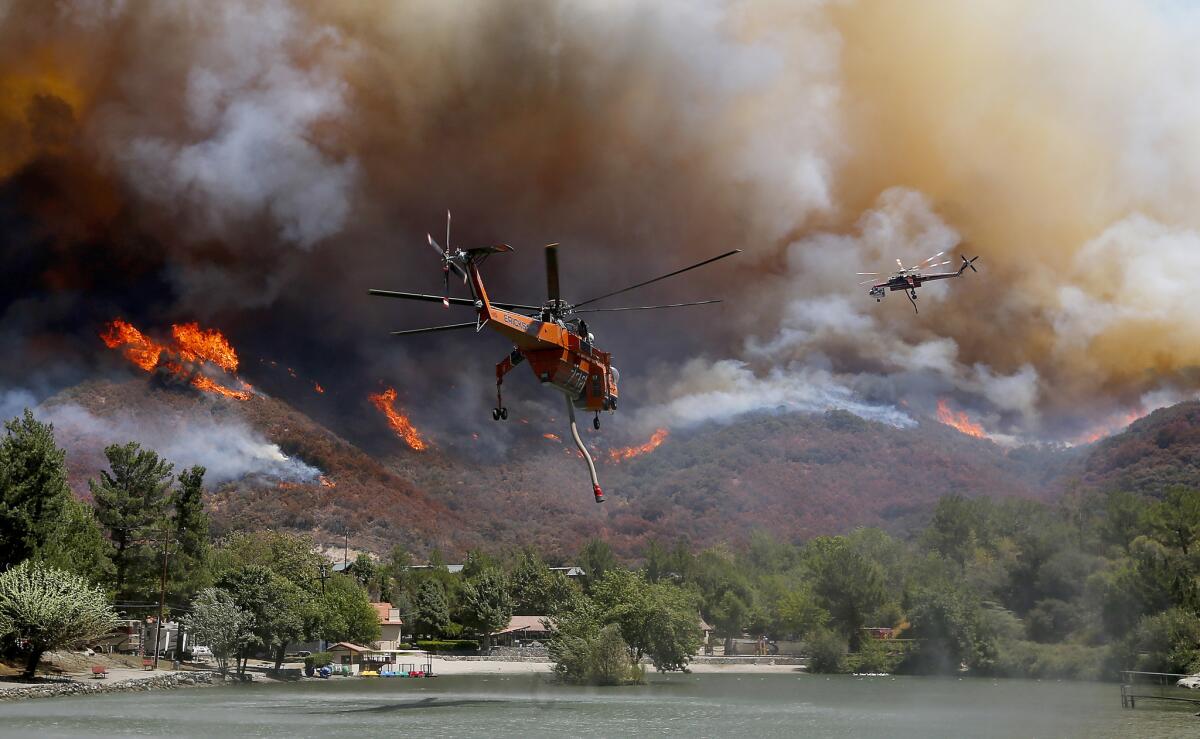
See more photos from the gallery >
Cheryl Anaya, 67, had pledged on Tuesday to stay as long as possible at her home in Lytle Creek in order to protect her two-story log cabin and other homes in the neighborhood.
On Wednesday afternoon, she was keeping to that pledge, even as firefighters fought to protect homes just across the road.
“We’re still holding our own,” Anaya said in a phone interview.
They night before, she said, it looked like things were calming and she believed the fire would soon be gone.
“We slept so good,” she said. “Then we woke up to helicopters and planes.”
Anaya believed that some cabins from an RV resort about two blocks from her home, and a number of other structures in the community, had been destroyed.
Like the day before, she said she would be ready to leave when the time came.
“The smoke looks bad,” she said. “We’ll go when we have to.”
- Share via
Dramatic images show the Blue Cut fire from space
The massive Blue Cut fire has destroyed homes and consumed more than 30,000 acres.
The fire has produced some dramatic images from the ground.
The scene is also remarkable from space. Various satellite images below show smoke from the fire as it burns:
- Share via
As Blue Cut fire looms, Wrightwood residents pack their bags
- Share via
Man accused of setting Lake County fire delays entering plea
Damin Pashilk, the Clearlake construction worker accused of setting the devastating Clayton fire and more than a dozen other blazes, postponed entering a plea Wednesday as he appeared in Lake County court.
Dressed in green-striped jail scrubs, the 40-year-old defendant sat in the jury box for his arraignment and sought to hide his face from the throng of media and area residents who attended the arraignment hearing.
Pashilk faces 17 felony counts of arson or attempted arson stretching back more than a year and is being held on $5-million bail.
Through his lawyer, Pashilk said he would enter a plea on Sept. 7.
- Share via
Blue Cut fire now major threat to Lytle Creek as flames march toward communities
The Blue Cut Fire was making a run at the Lytle Creek area on Wednesday afternoon, fueled by strong winds and high temperatures.
Of particular concern was the Mountain Lakes RV community, which was in the direct path of the flames, according to residents posting on social media.
KABC-TV footage showed flames marching down a hill and toward the RV park as well as other structures. The footage showed at least one structure burning.
Water-dropping choppers were in the area.
- Share via
California Trucking Assn. says impact of freeway closure is ‘unknown’
The California Trucking Assn. released a statement Wednesday on the effect of the Blue Cut fire, which has forced closure of the 15 Freeway in the Cajon Pass.
“At this time, the impact this freeway’s closure will have on truckers and goods movement is unknown,” CEO Shawn Yadon said.
“Like all Californians, our first concern is the safety of those in or near the fire and providing help to those in need. Our thoughts remain with the first responders fighting this devastating fire and the families affected by this tragedy.”
- Share via
Air assault on Blue Cut fire above Lytle Creek

- Share via
Blue Cut fire burning toward Phelan
- Share via
Striking photo shows intensity of Blue Cut fire
- Share via
The cause of most California wildfires? People
- Share via
Wrightwood evacuation holdouts explain why they won’t leave
Angela Adams did not like what she was seeing from her front door: a billow of smoke and flames on a mountain ridge not far from her home.
“I don’t like this view at all,” the 48-year-old said.
She had been keeping an eye on the mountain that sits across from her single-story Pacific Crest Estates home since 5 a.m.
Even though officials ordered mandatory evacuations in Wrightwood, she and hundreds of other residents had chosen to stay behind.
Why? Adams gave several reasons: She has friends who are firefighters who are updating her on the blaze, and she wants to make sure homes belonging to the families who did evacuate aren’t broken into, she said.
But there was also another reason — all of the snowboards, skateboards, hats and clothing that belonged to her 17-year-old son who died in a solo car accident in March.
“I just needed more time to pack,” she said. “I just have to have his stuff.”
Adams moved to Wrightwood from Mission Viejo about 12-years ago. Her husband at the time worked for the Food and Drug Administration and had been given the choice of transferring to San Bernardino County or Fresno.
“It was this or Fresno and I’m not moving over there, so we moved here,” she said.
State and federal fire authorities have announced mandatory evacuations for all of Wrightwood, and sheriff’s deputies went through the community late Tuesday night urging residents to leave.
However, not all residents received a visit by authorities. Until that happens, Adams and others said they would stay put.
An occupational therapist who manages the rehab department at Spring Valley Post Acute Care in Hesperia, Adams said she plans to leave the second she’s told to evacuate or sees the fire getting worse.
Standing nearby was her friend and neighbor, Asha Ramirez, 38, a realtor who said she’d do the same.
“I don’t want to make the firefighters’ job tougher than it already is,” Ramirez said, snapping photos of the large smoke cloud.
Ramirez, who has lived in the neighborhood for five years with her husband and three children, said she didn’t leave because she wanted to wait as long as possible before she was forced to leave. She also didn’t know exactly what to pack.
“I don’t know how long we’ll be gone,” she said. “Plus, once I go down the mountain, I can’t come back.”
She said she trusts firefighters will do everything they can to keep their homes safe when she leaves.
- Share via
WATCH: Firefighting helicopter scoops water from lake to fight Blue Cut fire
- Share via
‘This time we just decided to see what happens’; Wrightwood residents defy evacuation order
Ross Hansen lashed a blue duffel bag to the roof of his black SUV as flames crept slowly down a mountainside about two miles from his home Wednesday.
Although Ross and his wife Lisa were defying mandatory evacuation orders, they wanted to be ready to flee if they had to.
The Wrightwood couple said they have evacuated twice before in the past -- mostly because their children were home.
What they say they learned those two experiences though is that they never really had to leave their home to begin with. Nothing burned and firefighters proved to have an excellent track record of protecting the neighborhood.
“This time we just decided to see what happens,” he said.
The wind was relatively calm as Hansen explained himself Wednesday, and there were no drifting embers creating hot spots ahead of the fire. There wasn’t even ash and or smoke.
The couple also took comfort in the fact that there was a crew of firefighters nearby building fire lines and that their daughter was away at college. They said their son is a lot older now and that they didn’t have to worry as much.
“We’re good,” Ross Hansen said.
He said they’d evacuate if the fire reached the bottom of the mountain.
“It would be nice if we don’t have to,” he said.
- Share via
For one Clearlake resident displaced by the Clayton fire, a ‘go-bag’ is now a necessity
- Share via
‘We got our butts kicked’: Fire officials recount explosive growth of Blue Cut blaze
It was a recipe for flaming disaster.
Unrelenting heat, gusting winds and tinder-dry chaparral that would snap when touched provided bountiful ammunition for a fast-moving fire that incinerated 30,000 acres of Southern California terrain and forced more than 80,000 to evacuate.
The fire broke out late Tuesday morning in terrain so rugged and steep that “it’s like wadded-up paper” said Michael Wakoski, battalion chief of the San Bernardino County Fire Department and incident commander of the Blue Cut fire.
“It’s almost impossible to move up and down the slopes,” he said. “It makes containment of the fire very difficult.”
The Cajon Pass, a natural wind tunnel, created a funnel that increased wind speeds by 20 mph to 30 mph, pushing the blaze north and helping it jump the 15 Freeway, he said. The fire was spotting half a mile ahead of itself.
“You add the wind, the fuel and the lay of the land and they all line up for a disaster,” he said. “The brush is like stick. They just break off when you walk through them. It’s a disaster that has been waiting to happen all year, waiting for a spark.”
Authorities are still investigating the cause of the fire that was first reported Tuesday around 10 a.m.
When firefighters arrived, a cargo train moving through the Cajon Pass stood idle on the tracks, Wakoski said. The engineer had abandoned it.
Complicating containment was a patchwork of infrastructure that convenes in the Cajon Pass and services a large swath of Southern California, including electrical power lines, high-pressure gas lines, pipelines for jet fuel and a network of fiber-optic cables.
Firefighters fought hard to get ahead of the fire, but in the end, they could do little to contain it.
“We got our butts kicked,” Wakoski said.
The fire ripped through mountain pine trees, desert yucca, brush and chaparral.
“Fires burn differently in different types of fuel, so you will get a change in fire behavior very quickly. It can go from real slow burning to extreme burning in a heartbeat,” he said.
Three firefighters were treated and released for smoke inhalation.
Wakoski said in his 40-year career fighting fires, he never has seen anything like this.
“We are not even in the hot part of fire season yet,” he said. “This is October-like fire behavior conditions we’re having right now, and we’re only in August, so we are in for a fight.”
- Share via
Residents leave their homes ‘in God’s hands’
Mary Grass and her husband evacuated their home just above Highway 138 around 2 p.m. Tuesday.
The couple grabbed their horse, dropped it off at a friend’s house in Hesperia and spent the night in Victorville.
“Just wondering about our house now,” Grass, 74, said.
Grass said TV footage of the area showed homes near her neighborhood had burned down. Still, she was calm.
“It’s in God’s hands,” she said. “I’m OK with whatever he has for us.”
When she left her home Tuesday, Grass could see smoke and flames tearing through the hills around her.
“We knew we needed to get out,” said Grass, who has lived in the area for 30 years.
She and her husband have seen a few fires roll through the area, “but nothing like this,” she said. Some neighbors who were stuck at the bottom of the hill in San Bernardino have called to check on their homes, she added.
A couple of houses on the other side of the road have burned.
Grass said she and her husband might go to their daughter’s house nearby and stay there for the night.
“I’m not afraid,” she said. “I have peace. I’m so glad that I do.”
- Share via
These maps show the areas burned by the Blue Cut fire and which roads are closed as a result
- Share via
Stranded on the roadway as the Blue Cut fire burns
- Share via
‘It hit with an intensity we haven’t seen before,’ San Bernardino County fire chief says
In a word, San Bernardino County Fire Chief Mark Hartwig said, damage from the Blue Cut fire has been devastating.
“A lot of homes lost yesterday,” Hartwig said at a news conference Wednesday morning. “There will be a lot of families that will come home to nothing. If there’s a bright side, a silver lining, there are some homes that were saved.”
Hartwig told reporters defensive firefighting remains a priority for firefighters. The 30,000-acre fire remains 0% contained.
“Yesterday, it hit hard, it hit fast, it hit with an intensity that we haven’t seen before,” Hartwig said.
Mike Wakoski, incident commander of the Southern California Incident Management Team 3, said fuels in the area are extremely dry and very explosive.
“In my 40 years of fighting fire I’ve never seen a fire behavior so extreme as it was yesterday,” Wakoski said. “Yesterday’s actions were totally defensive.”
U.S. Forest Service officials said they “hit the fire pretty hard” and asked residents to evacuate -- not stick around to see what happens when authorities give the order.
“If we ask you to leave, you have to leave,” John Miller, spokesman for the U.S. Forest Service, told reporters. “The worst thing that can happen is for people to wait to the last minute, dial 911 and firefighters and law enforcement are unable to get people out of their homes.”
The fire in the Cajon Pass is the latest struggle in a challenging year filled with wildfires, officials said.
“We’re going to continue to hit this thing hard,” Miller said.
- Share via
Cadaver dogs headed to check homes along Highway 138, U.S. Forest Service says
Chon Bribiescas, a spokesman for the U.S. Forest Service, said fire officials would be sending assessment teams and cadaver dogs Wednesday morning to homes and structures along Highway 138.
There is no indication so far that anyone was killed, but the fire moved fast on Tuesday, Bribiescas said.
Many people “made the decision to shelter in place,” he said. “The fire came so quickly ... we want to make sure nobody was left behind.”
The assessment teams will also be charged with checking for damage at homes, Bribiescas said.
- Share via
Man accused of setting Lake County fire and many others will appear in court Wednesday
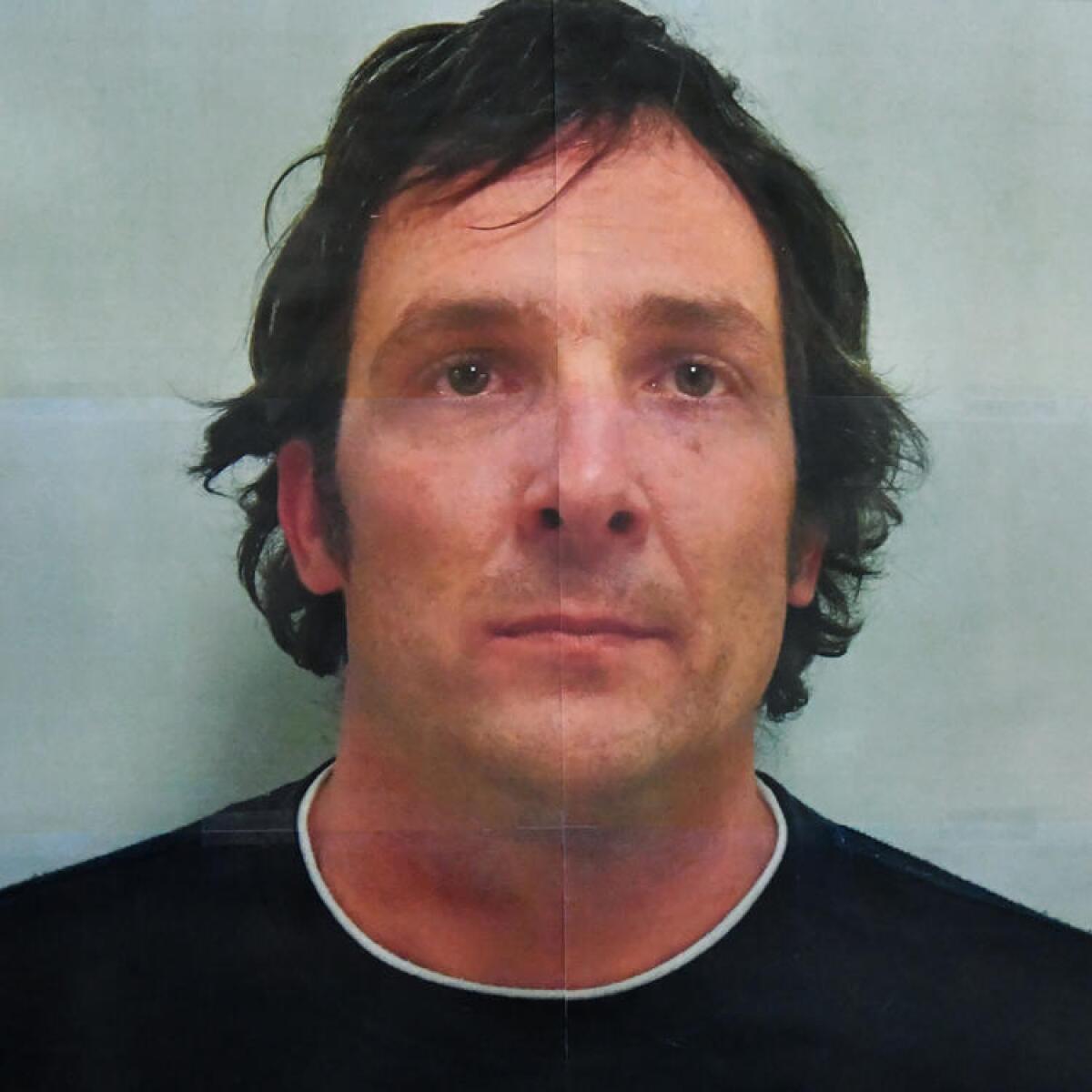
Damin Pashilk, suspected of being a serial arsonist, will be charged Wednesday with multiple counts of arson in connection with the Clayton fire and 11 other blazes since July 2015, according to prosecutors.
Lake County Chief Deputy Dist. Atty. Richard Hinchcliffe said Pashilk will face 17 felony counts of arson or attempted arson stretching back more than a year. The most recent blaze that he has been linked to by authorities consumed hundreds of homes in the area of Clearlake.
Pashilk, who was arrested Monday, will also be charged with possession of methamphetamine and driving without a license. The prosecutor said that Pashilk was not arrested while trying to start a fire, but said he had been under surveillance.
Pashilk, 40, has a lengthy record of arrests, according to officials.
“He is a familiar figure; mostly misdemeanors and some felonies here,” Hinchcliffe said.
- Share via
More than 10,000 firefighters are battling 8 large wildfires in California
- Share via
Surveying Phelan, a town affected by the Blue Cut fire
- Share via
Dramatic ‘fire tornadoes’ show intensity of devastating Blue Cut fire
The Blue Cut fire, which began in the Cajon Pass, has burned with an unusual ferociousness, firefighters say.
A sign of this are the so-called “fire tornadoes” that have been captured in video and still images. Here is some background from The Times archives.
What are fire tornadoes?
Known in the science community as a fire whirl, on social media they’ve become popularly known as a fire tornado or “firenado.” In fact, the phenomenon has been documented, and feared, for more than 100 years, according to a 2012 article in the Journal of Combustion.
What do we know about them?
A fire whirl can occur when trees, a hillside or even a wall of flames forces air to shift or rotate among competing air temperatures and speeds -- and eventually it tilts the rotating air from a horizontal position to a vertical one, giving it the tornado-like appearance.
Some fire whirls dissipate moments after starting because the heat and air flow that maintained them ventilate out. But others can travel and sustain themselves as the heat is lifted on buoyant air, and gas surrounding the whirl pushes it tighter into itself, making it more intense. The air inside the funnel can then act as a compressed, rotating column of gas, according to the study.
Scientists estimate fire whirls burn fuel three to seven times faster than an open flame.
- Share via
Hot spot in Phelan
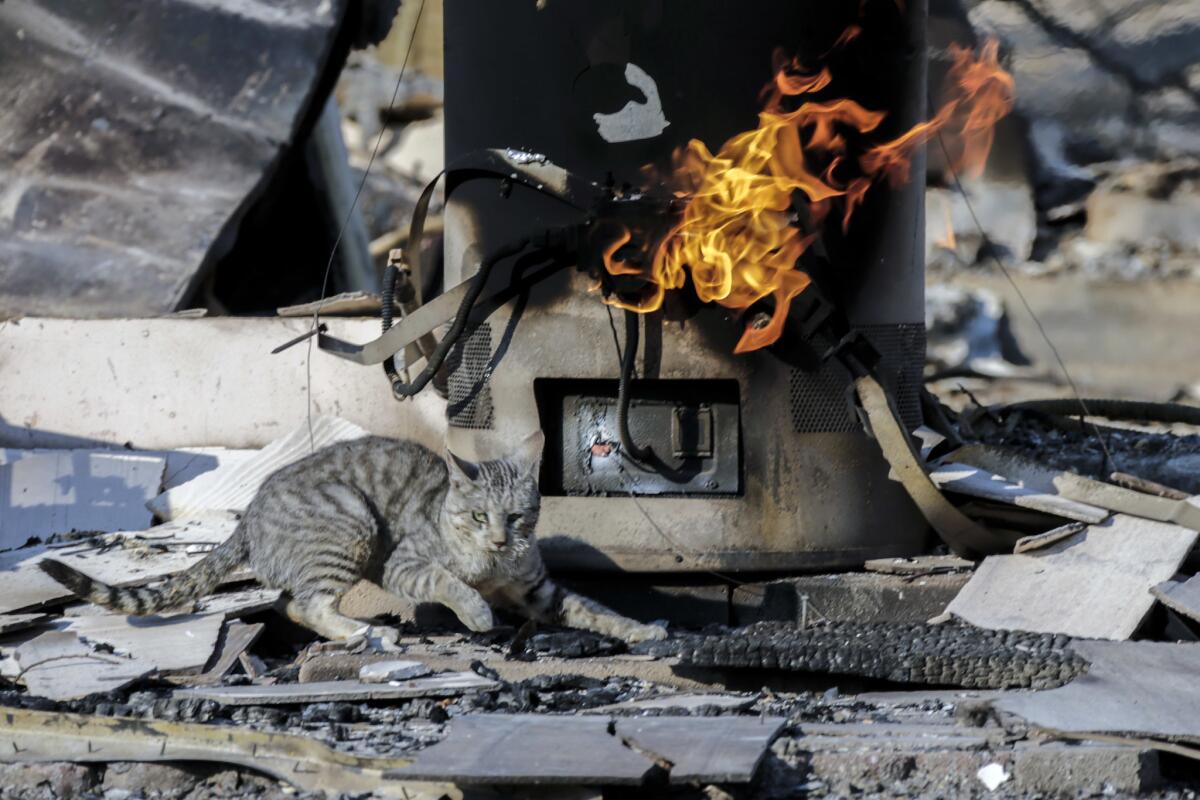
- Share via
Wind, fuel combine to ignite Blue Cut fire and ‘there’s nothing you can do about it’
Early Wednesday morning, Captain Howard Deets and the Mill Creek hotshots sat near Cajon Boulevard, monitoring the battle against a blaze that was consuming a hill nearby.
Crews on the ground cleared brush and laid hoses as flames flared along the ridge.
A perfect mix of circumstances had combined to create the fast-moving Blue Cut fire, Deets said.
It’s been 13 years since a large fire in this area left the hills and mountains covered in old, dead brush intermixed with new growth.
Then, on Tuesday, the wind moved in just the right way to get the fire going.
“It all aligned. The wind, the fuel and the topography,” Deets said. “When that happens there’s nothing you can do about it. You could throw the world’s fire fighting resources at it and it’s just going to keep going.”
- Share via
Smoke marks scenes of destruction
Times photographer Marcus Yam is back in the field this morning covering the Blue Cut fire. Here’s a look at what he’s seeing so far: